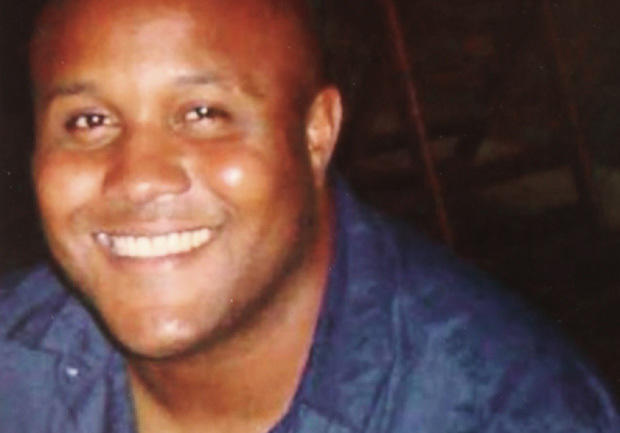Christopher Dorner Update: Ex-cop's body ID'd, cause of death unclear
(CBS/AP) LOS ANGELES - Investigators determined that the burned human remains found inside a cabin after a deadly shootout in the mountains in Southern California are those of Christopher Dorner, but there are still questions about how the ex-police officer accused of killing four people died.
Pictures: Ex-LAPD cop accused of going on killing spree
Sheriff-coroner's spokeswoman Jodi Miller announced Thursday that dental examination definitively showed that the remains were Dorner's.
Evidence including witness descriptions and a driver's license already had led authorities to figure that it was Dorner who exchanged heavy gunfire with San Bernardino County sheriff's deputies at a cabin Tuesday, killing one sheriff's deputy and never leaving as the cabin as it went up in flames.
Virtually no other information was released Thursday. An autopsy report on the charred body was still being completed, and toxicology tests typically take several weeks to return results.
That means questions are likely to linger over which of three ways Dorner may have died: Was it the hail of gunfire that came from the deputies outside? Was it suicide by the single shot that was heard from inside the cabin as the flames began to rise? Or was it the flames themselves that engulfed both Dorner and the cabin?
The cause of the flames remained in question in the days that followed Dorner's death on Tuesday.
After milder tear gas failed to bring Dorner out, deputies shot pyrotechnic tear gas canisters into the cabin. During a subsequent news conference, Sheriff John McMahon would only say that the fire broke out immediately after the canisters were sent in, stopping short of saying that they sparked the fire.
He added that the burning of the cabin "was not on purpose. We did not intentionally burn down that cabin to get Mr. Dorner out." Another news conference was scheduled for later Friday afternoon, but it was not clear what the department intended to reveal.
Meanwhile, court documents showed that Dorner gathered information on the women's basketball coach and her fiance before he apparently killed them earlier this month.
The Orange County Register reported that Irvine police believe Dorner researched 28-year-old Monica Quan and her 27-year-old boyfriend, Keith Lawrence, and that he may have had documents containing information about Quan and her family.
Police tied Dorner to the slayings after reading a manifesto he wrote in which he sought revenge against those he believed ended his law enforcement career. Quan's father represented Dorner during a disciplinary hearing.
The search for Dorner began last week after authorities said he had launched a deadly revenge campaign against the Los Angeles Police Department for his firing. The manifesto warned that he would bring "warfare" to LAPD officers and their families.
The manhunt for Dorner brought police to Big Bear Lake, 80 miles east of Los Angeles, after his burned-out pickup truck was found abandoned last week. His footprints disappeared on frozen soil and hundreds of officers who searched the area and checked out each building failed to find him.
Karen and Jim Reynolds were next to see him inside their cabin-style condo on Feb. 12 when they arrived to ready it for vacationers. The condo was located within 100 yards of a command post for the manhunt.
Dorner, who at the time was being sought for three killings, confronted the couple with a drawn gun, "jumped out and hollered 'stay calm,' " Jim Reynolds said at a news conference.
His wife screamed and ran, but Dorner caught her, Reynolds said. The couple said they were taken to a bedroom where Dorner ordered them to lie on a bed and then on the floor. Dorner bound their arms and legs with plastic ties, gagged them with towels and covered their heads with pillowcases.
"I really thought it could be the end," Karen Reynolds said.
The couple believed Dorner had been staying in the cabin since at least Feb. 8, the day after his burned truck was found nearby. Dorner told them he had been watching them by day from inside the cabin as they did work outside. The couple, who live nearby, only entered the unit on Tuesday.
"He said we are very hard workers," Karen Reynolds said.
After Dorner fled in their purple Nissan Rogue, Karen Reynolds managed to call 911 from a cellphone on the coffee table.
Police have not commented on the Reynolds' account, but the notion of Dorner being holed up just across the street from the command post was shocking to many, but not totally surprising to some experts familiar with the complications of such a manhunt.
"Chilling. That's the only word I could use for that," said Ed Tatosian, a retired SWAT commander for the Sacramento Police Department. "It's not an unfathomable oversight. We're human. It happens."
Law enforcement officers, who had gathered outside daily for briefings, were stunned by the revelation. One official later looking on Google Earth exclaimed that he'd parked right across the street from the Reynolds' cabin each day.
The sheriff's department refused to answer questions about how one of the largest manhunts in years could have missed Dorner.
Timothy Clemente, a retired FBI SWAT team leader who was part of the search for Atlanta Olympics bomber Eric Rudolph, said searchers had to work methodically. When there's a hot pursuit, they can run after a suspect into a building. But in a manhunt, the search has to slow down and police have to have a reason to enter a building.
"You can't just kick in every door," he said.
Complete coverage of Christopher Dorner on Crimesider
